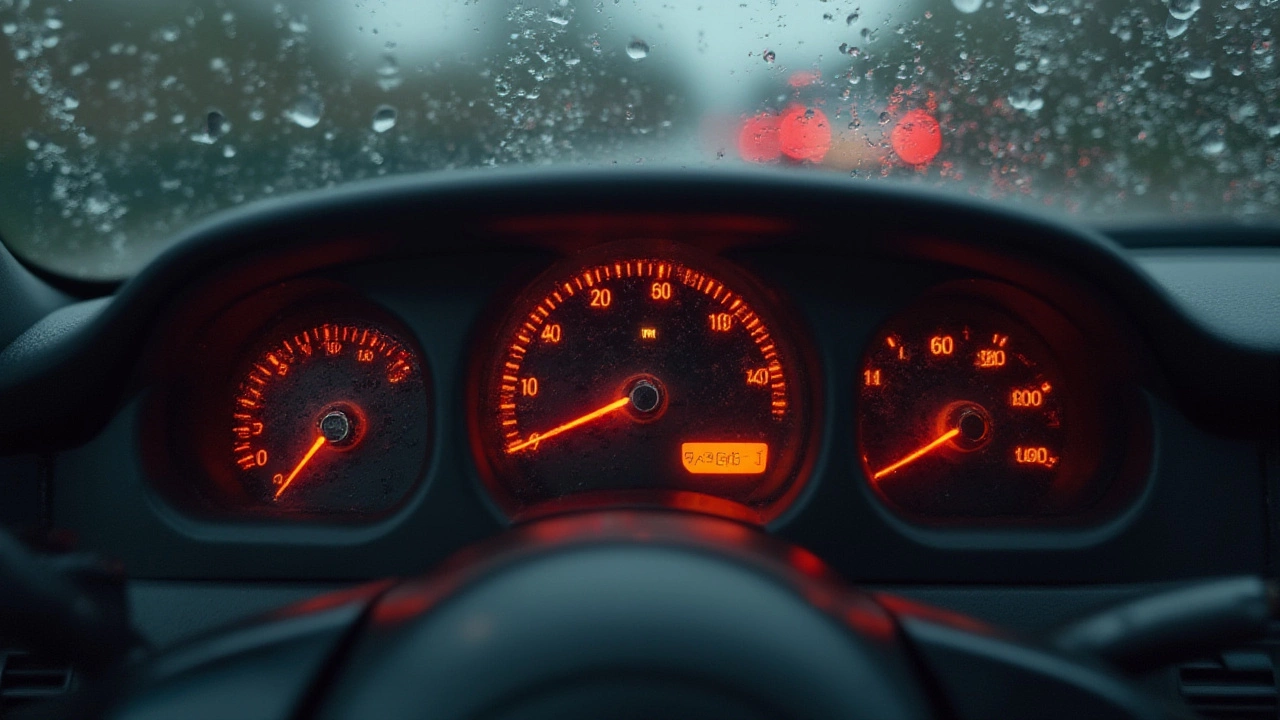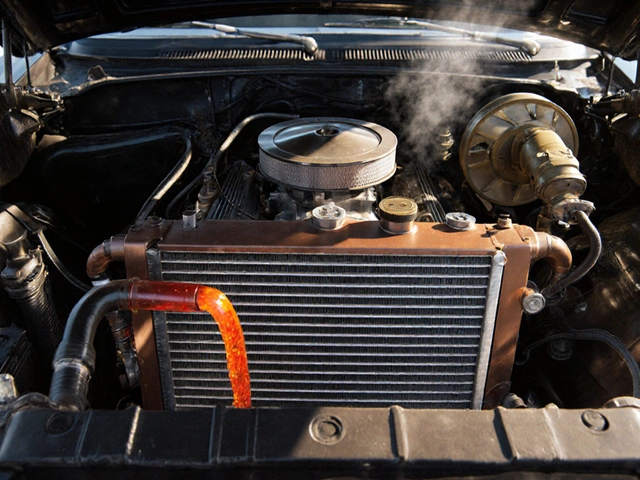You hop in your car, turn the key, and suddenly notice the temperature needle creeping up. Something’s not right. Still, life doesn’t wait, and maybe you think, “Can I make it another mile or two with a busted radiator?” Truth is, a failing radiator sets off a chain reaction that can fast-forward your engine’s demise. The stakes are higher than just a puddle under your car. Your radiator is like your car’s personal air conditioner, except its job is keeping the engine cool, not you. When it’s bad, things get hot. Fast.
Why Radiators Matter: The Heart of Engine Cooling
Your car’s radiator is the front-line defense against catastrophic engine heat. Every time you drive, the engine generates enough heat to melt metal. The radiator absorbs this heat from coolant that’s circulated through the engine, then releases it into the air. On average, an engine operates between 195°–220°F (90°–104°C). If temperatures climb higher, your engine gets closer to warping or cracking—a one-way ticket to a massive repair bill.
Now, here’s a wild stat: according to the National Highway Traffic Safety Administration, about 20% of roadside breakdowns are due to cooling system failures. That’s not a minor headache. It’s usually a direct result of neglected radiators, burst hoses, or missed maintenance. And it’s not just about heat—modern engines depend heavily on precise temperature control. Even a little overheating makes oil lose its protective kick, so moving metal parts grind in a losing battle.
Here’s another interesting point. Most radiators are made from lightweight aluminum now, instead of copper or brass like back in the day. Aluminum transfers heat super efficiently but damages easily. Even a little fender bender, or a stray stone, can bend fragile fins, causing leaks or blockages.
So, can you drive with a bad radiator? Here’s what you face: if coolant can’t travel or cool off, engine temperature skyrockets within minutes. Sometimes, it’s a slow leak and the gauge rises slowly; other times, you blow a hose and instantly pour coolant onto the pavement. Either way, engine damage starts happening a lot sooner than most people expect. As quoted in a recent
"If you suspect a cooling system problem, don't push your luck. Engines can suffer lasting damage in less than 5 minutes of severe overheating," — AAA Technical Services, 2024 report.
Let’s not sugarcoat it—your radiator is mission critical. Without it, you’re not just risking your engine, you’re rolling the dice on your whole car. Keep reading, because what comes next might make you rethink that ‘just a short drive’ idea.
What Happens When a Radiator Fails?
You know how touching a hot kettle can burn your hand in seconds? An uncooled engine works the same way, except on a much bigger (and more expensive) scale. The moment your radiator fails—be it from a crack, clog, or busted hose—your car’s entire cooling system loses balance. The engine’s core temperature rises, often silently at first, then with warning signs you can’t ignore: the temperature gauge spikes, steam bellows out from under the hood, and suddenly, dashboard lights turn into your worst nightmare.
Let’s break down what goes wrong in order:
- Coolant Loss: Any leak in the radiator or connecting hoses means coolant escapes. No coolant? No cooling. Temperatures start rising, sometimes within minutes, especially on hot days or in stop-and-go traffic.
- Poor Heat Dissipation: If your radiator’s clogged or the fan isn't working, coolant can’t cool off before heading back to the engine. The hotter it gets, the less it cools next time around.
- Pressure Build-Up: Modern cooling systems are pressurized to raise the boiling point of coolant above 212°F (100°C). A bad radiator can’t keep up pressure, so coolant boils off, leaving vapor instead of liquid. Vapors don’t move heat well, so things escalate.
- Steam and Overflows: Radiator caps are designed to release extra pressure, but if everything else is wrong, you’ll see geysers under the hood when things hit their boiling point.
- Engine Damage: With no cooling, the head gasket can blow, pistons can expand beyond their clearances, or—worst of all—the cylinder head or block can crack. At this stage, repairs are eye-watering, often totaling thousands of dollars.
People sometimes think they’ll spot every problem ahead of time. But, some cars have temperamental gauges. Some don’t even have one! By the time you see steam, real damage is already in progress. And if your car has an aluminum engine, which most modern vehicles do, the risk doubles. Aluminum warps at much lower temps than old cast iron blocks.
Even after cooling off, overheated engines can have invisible issues—warped heads, small internal cracks, or “cooked” oil seals that cause leaks later. It’s like catching the flu and thinking you’re fine, but your insides are still a mess. This is exactly why towing the car, not driving it, ends up being the smarter—and cheaper—move long-term.
Check out some real-world numbers below showing how fast things go wrong:
| Coolant Condition | Time to Danger | Engine Outcome |
|---|---|---|
| Full coolant, working radiator | Infinite (normal) | Healthy |
| Small leak | 15-30 minutes | First signs of overheating; minor damage possible |
| Burst radiator | 3-10 minutes | Major overheating, damage to head gasket, pistons |
| No coolant (dry) | Less than 5 minutes | Cracked block, complete engine seizure likely |
It’s a short window from “fine” to “fried.” Take that gamble, and your car could be ready for the scrapyard before you even finish the trip.

Signs and Symptoms of a Bad Radiator
So, how do you know your radiator’s on its last legs? Believe it or not, it’s not always a Hollywood cloud of steam. Sometimes the clues are subtle. Spotting trouble early can literally save your engine.
- Temperature Gauge Creep: The needle starts hovering on the high side, especially in traffic or hot weather. Ignore this, and you’re asking for major trouble.
- Rusty or Discolored Coolant: Peeking in the radiator (when cool!) shows brown, sludgy, or milky coolant. That’s a mix of rust, debris, and possibly oil—a sign the radiator’s corroding or leaking internally.
- Puddles Under the Car: You may find neon green, orange, or pink liquid on the ground. Different brands use different colors, but a puddle is never normal. It usually means a cracked tank, failed hose, or busted fitting.
- Visible Leaks or Cracks: Small white or green crusty deposits at radiator seams or hose connections can signal slow leaks. Catch these early and you might avoid disaster.
- Frequent Coolant Top-Ups: If the coolant reservoir keeps running low, you're probably losing coolant somewhere. Even with no visible leaks, internal cracks can leak coolant directly into the engine’s cylinders or oil.
- Steam or Sweet Smell: That weird, syrupy smell wafting through the vents is usually hot coolant vapor. If you get out and see a steamy cloud—pull over immediately.
- Heater Stops Working: It sounds backward, but if your cabin heater blows cold, it may be because low coolant isn’t reaching the heater core. That’s one of the more common early warning signs.
Modern cars may even flash a Check Engine or overheat warning before it gets obvious. Don't ignore these lights hoping they'll "fix themselves." In almost every case, leaving the radiator problem unfixed only gets pricier the longer you wait. And here's an interesting fact—AAA says nearly 40% of engine breakdowns come from cooling system neglect or delayed repairs. Most people think of belts and oil changes, but forget the radiator right up until something blows.
If you even suspect radiator problems, step one is to stop and check under the hood. You might just see a loose hose or catch a slow leak. If unsure, call for a tow or get a mechanic’s advice before driving another mile. It might feel dramatic, but a $75 tow beats a $3,500 engine replacement every single time.
How Far Can You Actually Drive With a Bad Radiator?
This is the million-dollar question. How many miles will your car limp along before serious trouble? There’s no hard-and-fast answer, because it depends on how ‘bad’ bad really is. If it’s a minor leak and coolant level is holding, you might get a few more trips—but the risk of suddenly going dry is always there. If your radiator’s just started leaking, temperatures may stay in the safe zone for 15-20 miles (sometimes less in summer). But if you lose all coolant, or if the radiator is blocked, most engines will overheat in under 5 miles. Dash lights and temperature warnings are usually lagging indicators—not real-time. If you’re on a highway in August with no coolant, your engine could seize up before you reach the next exit.
I’ve seen backyard mechanics try all sorts of roadside fixes—pouring in bottled water, sealing leaks with pepper or eggs, even taping hoses to squeeze out one last drive. None of these tricks work long-term. Even plain water (instead of proper coolant) boils and evaporates faster, leaving the system under-protected. Most pro mechanics suggest never risking more than a few miles with an overheating problem, since even a short stint can invite major engine trauma.
If a tow truck is out of reach and you’re forced to get the car home, here are some emergency steps:
- Turn off the A/C and crank the heater to maximum. This pulls heat away from the engine—uncomfortable, but effective in a pinch.
- Keep driving speed down and avoid hills or heavy throttle, which ramps up engine heat.
- Pull over at the first sign of the temperature gauge red-lining, steam, or dashboard warnings. Let the engine cool completely before attempting to add water or coolant.
- Never open the radiator cap while hot—it’ll shoot boiling fluid everywhere. Wait until it’s cool to the touch.
- Get professional help as soon as possible. Even if you make it home, lingering damage could show up days or weeks later.
Some drivers swear by temporary sealants or “stop-leak” products, but these only mask the real issue and can gum up the system. Think of it as a band-aid that might hold, or might blow off at the worst moment. The only true fix is a radiator repair or replacement, which, fortunately, is often less expensive than a new engine by a huge margin.
The harsh reality? The answer to "Can a car run with a bad radiator?" is yes, but only for a little while—and every mile comes with the risk of making today’s small problem tomorrow’s four-figure nightmare. If your radiator’s showing any signs of failure, treat it like you’re defusing a bomb. Most importantly, know your car—listen for changes, check your fluids, and don’t ignore the minor symptoms. That caution is the difference between a quick fix and a total breakdown.

